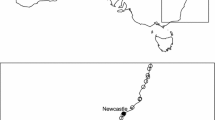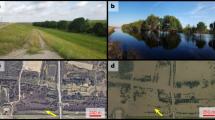Abstract
As a biological invasion proceeds, the spread of the alien may promote dispersal ability at the front by direct and indirect selection, thereby altering the dynamics of the invasion. Morphology correlates with dispersal in numerous taxa, and represents a relevant integration of temporal or geographical changes in dispersal. Using data from Laparie et al. (Biol Invasions 12:3405–3417, 2010) in a ground beetle introduced to a single location of the Kerguelen Islands in 1913, we examined the quantitative relationship between distance in residence time and morphological distance (computed from a multivariate combination of parameters). A consistent relationship depicted a quantitative match between differences in morphology and residence time. Body size increased from the founder population to successive child populations (femur, thorax, abdomen and head), which may indicate increasing dispersal ability along the colonization history of the species. The morphological differentiation may result from a combination of both dispersal pattern and residency effect in former populations, the latter leading to decreasing size when residence time increases, due to alteration of trophic conditions following invasion by the beetle. Our results offer a fertile ground for investigating spatial selection and promotion of dispersers on front margins, as they highlight the dynamic fashion of dispersal ability during invasions.



Similar content being viewed by others
References
Anholt BR (1990) Size-biased dispersal prior to breeding in a damselfly. Oecologia 83:387–395
Arnett AE, Gotelli NJ (2003) Bergmann’s rule in larval ant lions: testing the starvation resistance hypothesis. Ecol Entomol 28:645–650
Bergstrom DM, Chown SL (1999) Life at the front: history, ecology and change on southern ocean islands. Trends Ecol Evol 14:472–477
Berwaerts K, Van Dyck H, Aerts P (2002) Does flight morphology relate to flight performance? An experimental test with the butterfly Pararge aegeria. Funct Ecol 16:481–491
Bowler DE, Benton TG (2005) Causes and consequences of animal dispersal strategies: relating individual behaviour to spatial dynamics. Biol Rev 80:205–225
Cheptou PO, Carrue O, Rouifed S, Cantarel A (2008) Rapid evolution of seed dispersal in an urban environment in the weed Crepis sancta. Proc Natl Acad Sci USA 105:3796–3799
Chevrier M (1996) Introduction de deux espèces d’insectes aux Îles Kerguelen: processus de colonisation et exemples d’interactions. Ph.D Thesis, Université de Rennes 1, France, p 187
Crawley MJ (1989) Chance and timing in biological invasions. In: Drake JA, Mooney HA, di Castri F, Groves RH, Kruger FJ, Rejmánek M, Williamson M (eds) Biological invasions, a global perspective. Wiley, Chichester, pp 407–423
Davis MA (2009) Invasion biology. Oxford University Press, Oxford
Desender K (2000) Flight muscle development and dispersal in the life cycle of carabid beetles: patterns and processes. Bull Inst R Sci Nat Belg Entomol 70:13–31
Heidinger IMM, Hein S, Bonte D (2010) Patch connectivity and sand dynamics affect dispersal-related morphology of the blue-winged grasshopper Oedipoda caerulescens in coastal grey dunes. Insect Conserv Diver 3:205–212
Hill JK, Thomas CD, Blakeley DS (1999) Evolution of flight morphology in a butterfly that has recently expanded its geographic range. Oecologia 121:165–170
Hoffmann AA, Harshman LG (1999) Desiccation and starvation resistance in Drosophila: patterns of variation at the species, population and intrapopulation levels. Heredity 83:637–643
Holt RD (2003) On the evolutionary ecology of species’ ranges. Evol Ecol Res 5:159–178
Jeannel R (1940) Croisière du Bougainville aux îles australes françaises. III. Coléoptères. Mémoires du Muséum National d’Histoire Naturelle, France, série A 14:63–202
Lalouette L (2009) Impact de l’activité anthropique et des changements climatiques sur le succès envahissant de Merizodus soledadinus (Coleoptera, Carabidae) introduit aux îles Kerguelen. Ph.D Thesis, Université de Lyon 1, France, p 250
Laparie M, Lebouvier M, Lalouette L, Renault D (2010) Variation of morphometric traits in populations of an invasive carabid predator (Merizodus soledadinus) within a sub-Antarctic island. Biol Invasions 12:3405–3417
Laparie M, Larvor V, Frenot Y, Renault D (2012) Starvation resistance and effects of diet on energy reserves in a predatory ground beetle (Merizodus soledadinus; Carabidae) invading the Kerguelen Islands. Comp Biochem Phys A 161:122–129
Lawrence WS (1987) Dispersal—an alternative mating tactic conditional on sex-ratio and body size. Behav Ecol Sociobiol 21:367–373
Lebouvier M, Laparie M, Hullé M, Marais A, Cozic Y, Lalouette L, Vernon P, Candresse T, Frenot Y, Renault D (2011) The significance of the sub-Antarctic Kerguelen Islands for the assessment of the vulnerability of native communities to climate change, alien insect invasions and plant viruses. Biol Invasions 13:1195–1208
Li JB, Margolies DC (1994) Responses to direct and indirect selection on aerial dispersal behavior in Tetranychus urticae. Heredity 72:10–22
Matalin A (1994) The strategy of dispersal behaviour in some Carabidae species of Southeastern Europe. In: Desender K, Dufrêne M, Loreau M, Luff ML, Maelfait JP (eds) Carabid beetles: ecology and evolution. Kluwer Academic Publishers, Dordrecht, pp 183–188
Mossakowski D, Stier J (1983) Vergleichende Untersuchungen zur Laufgeschwindigkeit der Carabiden. In: Brandmayr P, den Boer PJ, Weber F (eds) Report of the fourth meeting of European Carabidologists: the synthesis of field study and laboratory experiment. Centre for Agricultural Publishing and Documentation, Wageningen, pp 19–33
Parmesan C (2006) Ecological and evolutionary responses to recent climate change. Annu Rev Ecol Evol Syst 37:637–669
Phillips BL, Brown GP, Webb JK, Shine R (2006) Invasion and the evolution of speed in toads. Nature 439:803
Phillips BL, Brown GP, Travis JMJ, Shine R (2008) Reid’s paradox revisited: the evolution of dispersal kernels during range expansion. Am Nat 172:S34–S48
Poniatowski D, Heinz S, Fartmann T (2012) The role of macropters during range expansion of a wing-dimorphic insect species. Evol Ecol 26:759–770
Reim C, Teuschl Y, Blanckenhorn WU (2006) Size-dependent effects of temperature and food stress on energy reserves and starvation resistance in yellow dung flies. Evol Ecol Res 8:1215–1234
Renault D (2011) Sea water transport and submersion tolerance as dispersal strategies for the invasive ground beetle Merizodus soledadinus (Carabidae). Polar Biol 34:1591–1595
Roff DA (1986) The evolution of wing dimorphism in insects. Evolution 40:1009–1020
Sax D, Stachowicz J, Brown J, Bruno J, Dawson M, Gaines S, Grosberg R, Hastings A, Holt R, Mayfield M (2007) Ecological and evolutionary insights from species invasions. Trends Ecol Evol 22:465–471
Simmons AD, Thomas CD (2004) Changes in dispersal during species’ range expansions. Am Nat 164:378–395
Thomas CD, Bodsworth EJ, Wilson RJ, Simmons AD, Davies ZG, Musche M, Conradt L (2001) Ecological and evolutionary processes at expanding range margins. Nature 411:577–581
Travis JMJ, Dytham C (2002) Dispersal evolution during invasions. Evol Ecol Res 4:1119–1129
Zera AJ, Denno RF (1997) Physiology and ecology of dispersal polymorphism in insects. Annu Rev Entomol 42:207–230
Acknowledgments
This research was supported by the Institut Polaire Francais (IPEV, programme 136 coordinated by Marc Lebouvier), the CNRS (Zone-Atelier de Recherches sur l’Environnement Antarctique et Subantarctique), and the Agence Nationale de la Recherche (ANR-07-VULN-004, Vulnerability of native communities to invasive insects and climate change in sub-Antarctic Islands, EVINCE).
Author information
Authors and Affiliations
Corresponding author
Rights and permissions
About this article
Cite this article
Laparie, M., Renault, D., Lebouvier, M. et al. Is dispersal promoted at the invasion front? Morphological analysis of a ground beetle invading the Kerguelen Islands, Merizodus soledadinus (Coleoptera, Carabidae). Biol Invasions 15, 1641–1648 (2013). https://doi.org/10.1007/s10530-012-0403-x
Received:
Accepted:
Published:
Issue Date:
DOI: https://doi.org/10.1007/s10530-012-0403-x




